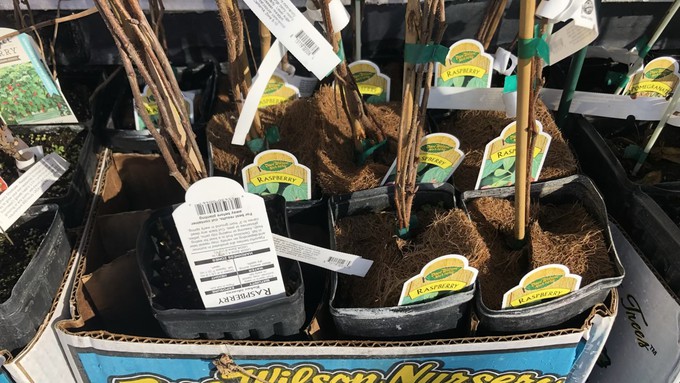
Fruit trees, roses, berries and more available 'naked' and ready to plant

These are raspberry bushes, packed in sleeves for bare-root planting. Many other types of berries, plus fruit trees and roses, are available this time of year as bare-root plants. Kathy Morrison
They look funny (because we’re not used to naked roots) and kind of counterintuitive (don’t plants need soil to live?), but they may be the best garden bargains you’ll find all year.
It’s bare-root season, which means nurseries are sporting sawdust-filled bins packed with dormant trees, shrubs and perennials. That sawdust helps protect those naked roots and keep them moist while the plants are out of the ground and “sleeping.”
Bare-root season allows growers and retail nurseries to save money, and some of those savings are passed onto buyers. Fruit trees, roses and other shrubs are dug up from growing fields in fall, then chilled in temperature-controlled warehouses; that pushes them into dormancy while keeping them fresh. They chill until they’re ready to ship to customers in winter.
Before or after shipping, growers and nurseries don’t have to repot bare-root stock. That saves on shipping costs (a bare-root fruit tree weighs a fraction of a tree in a pot full of soil) as well as time and labor.
The real bonuses are for the buyer. So much of a plant’s potential garden success is dependent on strong roots and here’s an opportunity to check them out. If bought in person, the plant can be inspected from top to bottom. Ideally, choose a tree or shrub with multiple, undamaged roots.
Another plus: Bare-root plants acclimate much faster than similar plants, transplanted from pots. Those naked roots can’t wait to get growing in their new surroundings. That gives the plant a head start on getting established (key to drought survival).
In addition, customers get more plant for their money. Bare-root fruit trees and roses are usually at least 3 years old; they’re mature plants. If bought in a pot, they’d cost significantly more.
Selection – especially of fruit trees, berries or roses – is never better than bare-root season. Nurseries don’t have physical space to keep lots of different varieties in stock in pots. But bare-root season allows for a full spectrum of varieties including many not available at any other time of year.
For fruit lovers, bare-root season is time to create your own diverse orchard or add favorites to your landscape. Among the fruit and nut trees available bare root: almond, apple, apricot, aprium, cherry, fig, jujube, mulberry, peach, pear, persimmon, plum, pluot and walnuts. This is also the time to find “fruit basket” trees with multiple varieties grafted onto the same trunk.
Both wine and table grapes are available bare root as well as many kinds of berries including blueberry, blackberry, boysenberry, currant, strawberry and raspberry. Perennial food plants such as horseradish and rhubarb are sold bare root, too.
Before transplanting, remember to give your new bare-root plant a drink. It can become dehydrated after so many weeks out of the ground. Soak the plant’s roots in a bucket or tub of water overnight.
For tips on selecting bare-root roses: https://bit.ly/3GlSuLb
Comments
0 comments have been posted.Sacramento Digs Gardening to your inbox.
Sites We Like
Garden Checklist for week of July 21
Your garden needs you!
* Keep your vegetable garden watered, mulched and weeded. Water before 8 a.m. to reduce the chance of fungal infection and to conserve moisture.
* Feed vegetable plants bone meal, rock phosphate or other fertilizers high in phosphate to stimulate more blooms and fruiting. (But wait until daily high temperatures drop out of the 100s.)
* Don’t let tomatoes wilt or dry out completely. Give tomatoes a deep watering two to three times a week.
* Harvest vegetables promptly to encourage plants to produce more. Squash especially tends to grow rapidly in hot weather. Keep an eye on zucchini.
* Pinch back chrysanthemums for bushy plants and more flowers in September.
* Remove spent flowers from roses, daylilies and other bloomers as they finish flowering.
* Pinch off blooms from basil so the plant will grow more leaves.
* Cut back lavender after flowering to promote a second bloom.
* It's not too late to add a splash of color. Plant petunias, snapdragons, zinnias and marigolds.
* From seed, plant corn, pumpkins, radishes, winter squash and sunflowers.